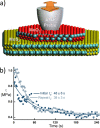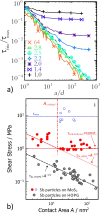Recent highlights in nanoscale and mesoscale friction
- PMID: 30116691
- PMCID: PMC6071713
- DOI: 10.3762/bjnano.9.190
Recent highlights in nanoscale and mesoscale friction
Abstract
Friction is the oldest branch of non-equilibrium condensed matter physics and, at the same time, the least established at the fundamental level. A full understanding and control of friction is increasingly recognized to involve all relevant size and time scales. We review here some recent advances on the research focusing of nano- and mesoscale tribology phenomena. These advances are currently pursued in a multifaceted approach starting from the fundamental atomic-scale friction and mechanical control of specific single-asperity combinations, e.g., nanoclusters on layered materials, then scaling up to the meso/microscale of extended, occasionally lubricated, interfaces and driven trapped optical systems, and eventually up to the macroscale. Currently, this "hot" research field is leading to new technological advances in the area of engineering and materials science.
Keywords: atomic force microscopy; dissipation; friction; mesoscale; nanomanipulation; nanoscale; scale bridging; structural lubricity; superlubricity.
Figures









References
-
- Martin J M, Erdemir A. Phys Today. 2018;71(4):40–46. doi: 10.1063/pt.3.3897. - DOI
-
- Persson B N J. Sliding Friction: Physical Principles and Applications. Berlin, Germany: Springer; 1998. - DOI
-
- Mate C M. Tribology on the Small Scale: A Bottom Up Approach to Friction, Lubrication, and Wear. Oxford, United Kingdom: Oxford University Press; 2008. - DOI
Publication types
LinkOut - more resources
Full Text Sources
Other Literature Sources
